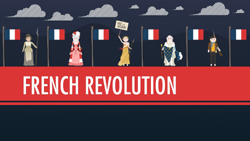-
Artistic movements are influenced by the society around them.
Romanticism was in part a reaction to the Industrial Revolution, while
advances in science contributed to a new movement called realism.
Romanticism was a reaction to the Enlightenment and to the
Industrial Revolution. Romantics believed that emotions, rather than
reason, should guide them. By the mid-nineteenth century, romanticism
had given way to a new movement called realism. Realists focused
on the everyday world and ordinary people.
Romanticism
-
In the arts, romanticism stressed individualism and emotion
instead of the Enlightenment’s focus on universalism and reason.
At the end of the eighteenth century, a new intellectual
movement, known as romanticism, emerged as a reaction to the ideas of the
Enlightenment.
romanticism
a movement in the arts and literature that originated
in the late 18th century, emphasizing inspiration, subjectivity, and the
primacy of the individual.
The Enlightenment had stressed reason as the chief means
for discovering the objective truth. The romantics emphasized feelings,
emotion, and imagination as sources of knowing.
Through music, literature, and painting, the romantic
artists attempted to stir the emotions.
The romantics believed that emotion and sentiment were
only understandable to the person experiencing them. In their novels, romantic
writers created figures who were often misunderstood and rejected by society
but who continued to believe in their own worth through their inner feelings.
Romantics also valued individualism, the belief in the
uniqueness of each person. Many romantics rebelled against middleclass
conventions. Male romantics grew long hair and beards and both men and
women wore outrageous clothes to express their individuality.
Many romantics had a passionate interest in the past ages,
especially the medieval era. They felt it had a mystery and interest in
the soul that their own industrial age did not.
Many romantics felt that industrialization would take
people away from nature.
Neo-Gothic
Romantic architects revived medieval styles and built
castles, cathedrals, city halls, parliamentary buildings, and even railway
stations in a style called neo-Gothic. The British Houses
of Parliament in London are a prime example of this architectural style.
Romanticism in Art and Music
Romantic artists shared at least two features. First,
to them, all art was a reflection of the artist’s inner feelings. A painting
should be the instrument of the revelation of the artist’s vision of the
world and mirror the artist’s own imagination. Second, romantic artists
abandoned classical reason for warmth and emotion.
Eugène Delacroix was one of the most famous romantic
painters from France. His paintings showed two chief characteristics: a
fascination with the exotic and a passion for color. His works reflect
his belief that “a painting should be a feast to the eye.”
Many of Delacroix’s paintings depicted scenes of uprisings
against tyrants. His most influential work is perhaps Liberty Leading the
People. In this painting, a woman holding a red banner is the symbol
of liberty. She is leading revolutionaries forward during battle.
After his travels to Spain and North Africa, Delacroix
painted the animals he had seen there. The Lion Hunt is a good example
of his later subjects.
In music, too, romantic trends dominated the first half
of the nineteenth century.
One of the most famous composers of this era was Ludwig
van Beethoven.
Ludwig van Beethoven
Some have called him a bridge between classical and romantic
music. Others argue that he was such a rare genius he cannot be easily
classified.
While Beethoven’s early work fell largely within the classical
form of the eighteenth century, his later workshis Third Symphony embodied
the elements of romanticism with powerful melodies that created dramatic
intensity.
In one way, Beethoven was definitely a romantic. He thought
of himself as an artist, not a craftsman. He had an intense and difficult
personality but was committed to writing music that reflected his deepest
feelings. “I must write, for what weighs on my heart, I must express.”
Romanticism in Literature
Like the visual arts, the literary arts were deeply affected
by romanticism and reflected a romantic interest in the past.
Sir Walter Scott, Ivanhoe
a bestseller in the early 1800s, told of clashes
between knights in medieval England.
Many romantic writers chose medieval subjects and created
stories that expressed their strong nationalism.
An attraction to the exotic and unfamiliar gave rise to
Gothic literature. Chilling examples are Mary Shelly's Frankenstein
in Britain and Edgar Allen Poe’s short stories of horror in the
United States.
Some romantics even sought the unusual in their own lives.
They explored their dreams and nightmares and sought altered states of
consciousness.
For the true romantic, poetry was the ideal art form.
The romantics viewed poetry as the direct expression of the soul.
Romantic poetry gave expression to one of the most important
characteristics of romanticism—its love of nature. Romantics believed that
nature served as a mirror into which humans could look to learn about themselves.
This is especially evident in the poetry of William Wordsworth,
the foremost English romantic poet of nature.
William Blake, Songs of Innocence and Songs
of Experience
New Age of Science
-
Rapid advances in science and technology fueled industrial
growth, made medical care more effective, and challenged religious faith.
New Discoveries
The Scientific Revolution had created a modern, rational
approach to the study of the natural world. For a long time, only the educated
elite understood its importance.
With the Industrial Revolution, however, came a heightened
interest in scientific research. By the 1830s, new discoveries in science
had led to many practical benefits that affected all Europeans. Science
came to have a greater and greater impact on people.
In biology, the Frenchman Louis Pasteur
proposed the germ theory of disease, which was crucial to the development
of modern scientific medical practices.
In chemistry, the Russian Dmitry Mendeleyev
in the 1860s classified all the material elements then known on the basis
of their atomic weights.
In Great Britain, Michael Faraday put together
a primitive generator that laid the foundation for the use of electric
current.
Dramatic material benefits such as these led Europeans
to have a growing faith in science. This faith, in turn, undermined the
religious faith of many people.
It is no accident that the nineteenth century was an age
of increasing secularization, indifference to or rejection
of religion in the affairs of the world. For many people, truth was now
to be found in science and the concrete material existence of humans.
Charles Darwin
More than anyone else, it was Charles Darwin
who promoted the idea that humans are material beings who are part of the
natural world.
Charles Darwin, On the Origin of Species by Means
of Natural Selection, 1859
organic evolution
The principle set forth by Charles Darwin that every
plant or animal has evolved, or changed, over a long period of time from
earlier, simpler forms of life to more complex forms
According to Darwin, in every species, “many more individuals
of each species are born than can possibly survive.” This results in a
“struggle for existence.”
Darwin believed that some organisms are born with variations,
or differences, that make them more adaptable to their environment than
other organisms, a process that Darwin called natural selection.
natural selection
The principle set forth by Charles Darwin that some organisms
are more adaptable to the environment than others; in popular terms, “survival
of the fittest”
Those organisms that are naturally selected for survival
(“survival of the fittest”) reproduce and thrive. The unfit do not survive.
The fit that survive pass on the variations that enabled them to survive
until, according to Darwin, a new, separate species emerges.
In The Descent of Man,
published in 1871, Darwin argued that human beings had
animal origins and were not an exception to the rule governing other species.
Darwin’s ideas raised a storm of controversy.
Some people did not take his ideas seriously. Other people
objected that Darwin’s theory made human beings ordinary products of nature
rather than unique creations of God. Others were bothered by his idea of
life as a mere struggle for survival.
“Is there a place in the Darwinian world for moral values?”
they asked. Some believers felt Darwin had not acknowledged God’s role
in creation. Some detractors scorned Darwin and depicted him unfavorably
in cartoons. Gradually, however, most scientists and other intellectuals
came to accept Darwin’s theory. His theory changed thinking in countless
fields from biology to anthropology.
Realism
-
The rise of science encouraged writers and artists to create
realistic works that portrayed even the poor and degraded in society.
realism
Mid-nineteenth century movement that rejected romanticism
and sought to portray lower- and middle-class life as it actually was
Realism in Literature
The literary realists of the mid-nineteenth century rejected
romanticism. They wanted to write about ordinary characters from life,
not romantic heroes in exotic settings. They also tried to avoid emotional
language by using precise description. They preferred novels to poems.
Many literary realists combined their interest in everyday
life with an examination of social issues. These artists expressed their
social views through their characters.
The French author Gustave Flaubert, who
was a leading novelist of the 1850s and 1860s, perfected the realist novel.
His work Madame Bovary presents a critical description of
small-town life in France.
In Great Britain, Charles Dickens became
a huge success with novels that showed the realities of life for the poor
in the early Industrial Age. Novels such as Oliver Twist
and David Copperfield created a vivid picture of the brutal
life of London’s poor, as well as of their humor and humanity. In fact,
his characters were so sympathetic that they helped inspire social reform.
Realism in Art
In art, too, realism became dominant after 1850. Realist
artists sought to show the everyday life of ordinary people and the world
of nature with photographic realism.
The French painter Gustave Courbet was the
most famous artist of the realist school. He loved to portray scenes from
everyday life. His subjects were factory workers and peasants. “I have
never seen either angels or goddesses, so I am not interested in painting
them,” Courbet once commented. There were those who objected to Courbet’s
“cult of ugliness” and who found such scenes of human misery scandalous.
To Courbet, however, no subject was too ordinary, too harsh, or too ugly.
REVIEW & DO
NOW
Answer the following questions in your spiral notebooks: |
| . |
. |
|
|
|





